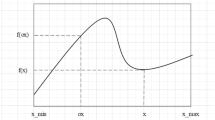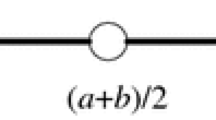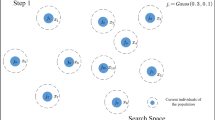Abstract
This paper proposes using the opposition-based learning (OBL) strategy in the shuffled differential evolution (SDE). In the SDE, population is divided into several memeplexes and each memeplex is improved by the differential evolution (DE) algorithm. The OBL by comparing the fitness of an individual to its opposite and retaining the fitter one in the population accelerates search process. The objective of this paper is to introduce new versions of the DE which, on one hand, use the partitioning and shuffling concepts of SDE to compensate for the limited amount of search moves of the original DE and, on the other hand, employ the OBL to accelerate the DE without making premature convergence. Four versions of DE algorithm are proposed based on the OBL and SDE strategies. All algorithms similarly use the opposition-based population initialization to achieve fitter initial individuals and their difference is in applying opposition-based generation jumping. Experiments on 25 benchmark functions designed for the special session on real-parameter optimization of CEC2005 and non-parametric analysis of obtained results demonstrate that the performances of the proposed algorithms are better than the SDE. The fourth version of proposed algorithm has a significant difference compared to the SDE in terms of all considered aspects. The emphasis of comparison results is to obtain some successful performances on unsolved functions for the first time, which so far have not been reported any successful runs on them. In a later part of the comparative experiments, performance comparisons of the proposed algorithm with some modern DE algorithms reported in the literature confirm a significantly better performance of our proposed algorithm, especially on high-dimensional functions.






Similar content being viewed by others
References
Ahandani MA, Shirjoposht NP, Banimahd R (2010) Three modified versions of differential evolution algorithm for continuous optimization. Soft Comput 15:803–830
Rashid M, Baig, AR (2010) Improved opposition-based PSO for feedforward neural network international conference on training. Information Science and Applications (ICISA2010), Seoul, pp 1–6
Balamurugan R, Subramanian S (2009) Emission-constrained dynamic economic dispatch using opposition-based self-adaptive differential evolution algorithm. Int Energy J 10:267–277
Becker W, Yu X, Tu J (2005) EvLib: a parameterless self-adaptive real-valued optimisation library. In: The 2005 IEEE congress on evolutionary computation CEC2005
Bhattacharya A, Chattopadhyay P (2010) Solution of economic power dispatch problems using oppositional biogeography-based optimization. Electr Power Compon Syst 38:1139–1160
Boskovis B, Brest J, Zamuda A, Greiner S, Zumer V (2011) History mechanism supported differential evolution for chess evaluation function tuning. Soft Comput 15:667–682
Brest J, Greiner S, Boskovic B, Mernik M, Zumer V (2006) Self-adapting control parameters in differential evolution: a comparative study on numerical benchmark problems. IEEE Trans Evol Comput 10:646–657
Brest J, Boskovic B, Greiner S, Zumer V, Maucec MS (2007) Performance comparison of self-adaptive and adaptive differential evolution algorithms. Soft Comput 11:617–629
Bui LT, Shan Y, Qi F, Abbass HA (2005) Comparing two versions of differential evolution in real parameter optimization. In: The 2005 IEEE congress on evolutionary computation CEC2005
Caponio A, Neri F, Tirronen V (2009) Super-fit control adaptation in memetic differential evolution frameworks. Soft Comput 13:811–831
Dorigo JM, Gambardella LM (1997) Ant colony system: a cooperative learning approach to the traveling salesman problem. IEEE Trans Evol Comput 1(1):53–66
Ergezer M, Simon D, Du D (2009) Oppositional biogeography-based optimization. In: IEEE Conference on Systems, Man, and Cybernetics. San Antonio, Texas, pp 1035–1040
Eusuff MM, Lansey KE (2003) Optimization of water distribution network design using the shuffled frog leaping algorithm. J Water Res Plane Manag 129:210–225
Feoktistov V (2006) Differential evolution: in search of solutions. In: Optimization and its applications, vol 5. Springer, New York
Garcia S, Molina D, Lozano M, Herrera F (2009) A study on the use of non-parametric tests for analyzing the evolutionary algorithms’ behaviour: a case study on the CEC’2005 special session on real parameter optimization. J Heuristics 15:617–644
Han L, He X (2007) A novel opposition-based particle swarm optimization for noisy problems. In: Proceedings of the third international conference on natural computation, vol 3. IEEE press, pp 624–629
Hansen N (2005) Compilation of results on the CEC benchmark function set. http://www.ntu.edu.sg/home/epnsugan/index_files/CEC05/compareresults.pdf
Holland J (1975) Adaptation in natural and artificial systems. The University of Michigan Press, Ann Arbor
Kennedy J, Eberhart RC (1995) Particle swarm optimization. In: Proceedings of the IEEE International Conference on Neural Networks, pp 1942–1948
Kirkpatrick S, Gelatt CD, Vecchi MP (1983) Optimization by simulate annealing. Science 220:671–680
Kofjac D, Kljajic M (2008) Application of genetic algorithms and visual simulation in a real-case production optimization. WSEAS Trans Syst Control 3:992–1001
Liu J, Lampinen J (2005) A fuzzy adaptive differential evolution algorithm. Soft Comput 9:448–469
Liu B, Wang L, Jin Y-H, Huang D-X, Tang F (2007) Control and synchronization of chaotic systems by differential evolution algorithm. Chaos Soliton Fract 34:412–419
Malisia AR, Tizhoosh HR (2007) Applying opposition-based ideas to the ant colony system. In: Proceedings of the IEEE symposium on foundations of computational intelligence (SIS 2007). Honolulu, Hawaii, pp 182–189
Moscato P (1989) On evolution, search, optimization, genetic algorithms and martial arts: toward memetic algorithm. Technical Report Caltech Concurrent Computation Program: Report 26, California Institute of Technology
Neri F, Tirronen V (2009) Scale factor local search in differential evolution. Memet Comp 1:153–171
Neri F, Tirronen V (2010) Recent advances in differential evolution: a review and experimental analysis. Artif Intell Rev 33:61–106
Omran MGH (2009) Using opposition-based learning with particle swarm optimization and barebones differential evolution. In: Lazinica A (ed) Particle swarm optimization. In Tech, pp 373–384
Perez-Bellido AM, Salcedo-Sanz S, Ortiz-Garcia EG, Portilla-Figueras JA, Lopez-Ferreras F (2008) A comparison of memetic algorithms for the spread spectrum radar polyphase codes design problem. Eng Appl Artif Intel 21:1233–1238
Plagianakos VP, Tasoulis DK, Vrahatis MN (2008) A review of major application areas of differential evolution. In: Chakraborty UK (ed) Advances in differential evolution of studies in computational intelligence, vol 143. Springer, Berlin, pp 197–238
Qin AK, Suganthan PN (2005) Self-adaptive differential evolution algorithm for numerical optimization. In: The 2005 IEEE congress on evolutionary computation CEC2005, vol 13, pp 1785–1791
Qin AK, Huang VL, Suganthan PN (2009) Differential evolution algorithm with strategy adaptation for global numerical optimization. IEEE Trans Evol Comput 13:398–417
Rahnamayan S, Wang GG (2008) Investigating in scalability of opposition-based differential evolution. WSEAS Trans Comput 7:1792–1804
Rahnamayan S, Tizhoosh HR, Salama MMA (2006) Opposition versus randomness in soft computing techniques. Elsevier J Appl Soft Comput 8(906):918
Rahnamayan S, Tizhoosh HR, Salama MMA (2008) Opposition-based differential evolution. IEEE Trans Evol Comput 12:64–79
Shokri M, Tizhoosh HR, Kamel M (2006) Opposition-based Q(λ) algorithm. In: Proceedings of IEEE World Congress on Computational Intelligence. Vancouver, BC, Canada, pp 646–653
Storn R, Price K (1997) Differential evolution—a simple and efficient heuristic for global optimization over continuous spaces. J Global Optim 11:341–359
Subudhi B, Jena D (2009) Nonlinear system identification using opposition based Learning differential evolution and neural network techniques. IEEE J Intell Cybern Syst 5:1–13
Suganthan PN, Hansen N, Liang JJ, Deb K, Chen Y-P, Auger A, Tiwari S (2005) Problem definitions and evaluation criteria for the CEC 2005 special session on real-parameter optimization. Technical Report Report #2005005, Nanyang Technological University, Singapore and IIT Kanpur, India. http://www.ntu.edu.sg/home/EPNSugan/
Teng NS, Teo J, Hijazi MHA (2009) Self-adaptive population sizing for a tune-free differential evolution. Soft Comput 13:709–724
Tizhoosh HR (2005) Opposition-based learning: a new scheme for machine intelligence. In: Proc Int Conf Comput Intell Modeling Control and Autom, vol 1. Vienna, Austria, pp 695–701
Tizhoosh HR (2006) Opposition-based reinforcement learning. J Adv Comput Intell Intell Inf 10:578–585
Ventresca M, Tizhoosh HR (2006) Improving the convergence of backpropagation by opposite transfer functions. In: Proceedings of IEEE World Congress and Computational Intelligence. Vancouver, BC, Canada, pp 9527–9534
Ventresca M, Tizhoosh HR (2007) Simulated annealing with opposite neighbors. In: Proceedings of the IEEE Symposium on Foundations of Computational Intelligence (SIS 2007). Honolulu, Hawaii, pp 186–192
Wang H, Liu Y, Zeng S, Li C (2007) Opposition-based particle swarm algorithm with Cauchy mutation. In: Proceedings of the IEEE Congress on Evolutionary Computation, pp 4750–4756
Author information
Authors and Affiliations
Corresponding author
Rights and permissions
About this article
Cite this article
Ahandani, M.A., Alavi-Rad, H. Opposition-based learning in the shuffled differential evolution algorithm. Soft Comput 16, 1303–1337 (2012). https://doi.org/10.1007/s00500-012-0813-9
Published:
Issue Date:
DOI: https://doi.org/10.1007/s00500-012-0813-9




